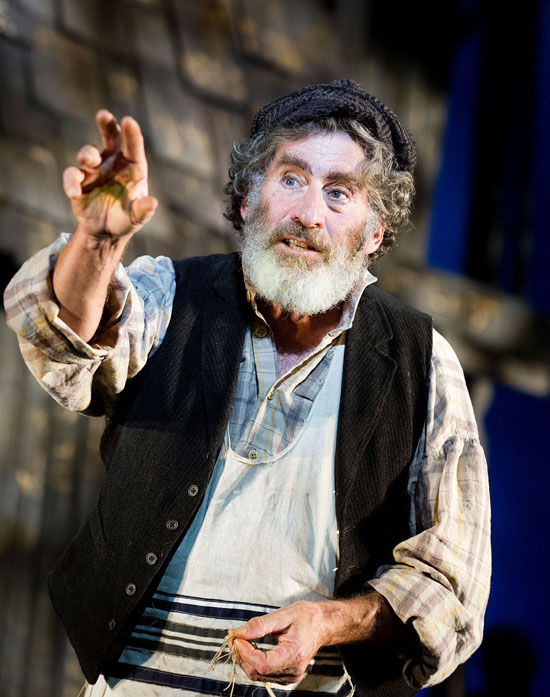
On the face of it life in a remote Russian village in 1905 with its poverty and the threat of pogroms hanging over it does not sound very promising material for a stage musical. Based on the 1894 Tevye and his Daughters and other Yiddish stories by Sholem Aleichem, the show’s title was inspired by Marc Chagall’s painting The Fiddler. The violin is a metaphor for survival, through tradition and joyfulness. But what Fiddler on the Roof demonstrates, as have many great works of arts before it, is that subject is far less important than implementation. A great work of art can be made from anything. It’s the art that counts, not the thing.
Fiddler is certainly a work of art. It has all the ingredients – surface appeal, inspiration, originality, hidden depths and integrity. Fiddler’s plot, as such, is quite thin. It is more a series of tableaux, each I suspect originating from one of Aleichem’s tales, but there are strong and tangible undercurrents throughout.
There are fearful indications of what is to come with the Russian pogroms and later, Hitler’s Holocaust. But that was nothing new. The Jews have always had a hard time and not just in Eastern Europe – our very own York massacred its Jewish population in 1190 and Jews were banned from England until 1656.
As a result of the persecutions, Jewish security has always been in faith and tradition rather than in place and fixed property. They were always likely to be uprooted and moved on, which is why perhaps, as Tevye quips, they always keep their hats on. Tevye is a man of infinite wisdom, understanding and tolerance, a dreamer bravely keeping his head above the waters in his sea of sorrow. One can almost believe that he is a Tzadik Nistar, a hidden righteous one, a just man.
From Tradition, the opening number, it is clear in which direction we will be led. The story is simple. Tevye, a poor milkman, has five daughters, three of whom during the course of the story want to marry. And therein lies the problem. The tradition is that girls do not decide such things for themselves, which is why the community has a perfectly good matchmaker. In the second (and best) song in the show, Matchmaker, the girls hope they will be pared off with somebody nice, but their hearts are not in it. They each, in turn, find their own love and, after initial resistance, Tevye gives his blessing. However, when the third daughter runs off with a goy boy it is too much to bear. Reconciliation seems impossible and with almost his last words in the show, Tevye finally cries out his blessing to the disappearing couple as the community disperses into an unknown future.
Apart from Matchmaker, it is difficult to pick out any high-spots. Fiddler on the Roof is just one high-spot after another. Because of the tableaux nature of the piece each song is a large production number which manages to be breathtakingly spectacular and moves the story along. The dream sequence at the end of the first half was probably the most spectacular and I loved To Life with the dancers leaping around with bottles on their heads.
Visually the show is stunning but would, I’m sure, look better on a slightly bigger stage than the Everyman. The large company are all excellent and double as the orchestra. Each member of the company has to sing, act, play instruments and dance, often all at the same time – and holding a conversation while playing a clarinet is no mean feat. They are all superb and it would be unfair to mention one in particular. That said, the ever-present fiddler who plays on the roof is a nice link and is whispishly played by Jennifer Douglas almost as a Shakespearean Ariel.
Paul Michael Glaser is a very laid-back Tevye whose presence anchors not only his community but the show itself. I’d never seen Fiddler on the Roof before and am really glad that situation has now been rectified. This is a show and a production of the highest quality with which it would be almost impossible to find fault. ★★★★★ Michael Hasted


